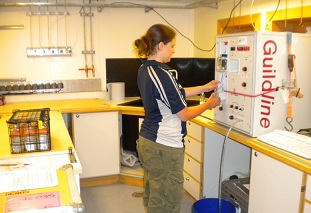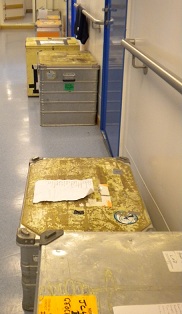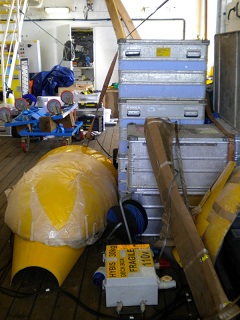Tuesday 20th April
Last night we deployed the CTD probe for the final time in the Cayman Trough, and then ran some survey lines with the magnetometer before setting course for Jamaica, where this expedition will end. PhD student Sarah spent several hours analysing water samples collected by the CTD probe overnight, using an instrument called a salinometer to measure the salt content of the water as part of our physical oceanography research programme.

The magnetometer, which we are towing behind the ship, is the last instrument that we will be using. As we run the magnetometer away from the volcanic rift, geophysicist Nancy from the University of North Carolina Wilmington will use its data to examine the rates at which the tectonic plates have moved in the past. We know that the plates are moving apart very slowly at the rift today, but we don't know whether this has always been the case - and that knowledge may help us to understand the geological features that we have found on our maps. Commenting on the expedition, Nancy said she had been 'wowed by the success of the multi-disciplinary science and technical team, working together to discover deep-sea vents in a relatively short period of time, and using exactly the right equipment.'
We should arrive in Montego Bay tomorrow evening, which gives us a day to complete the expedition report, and pack up our laboratories and equipment. Consequently there are crates and boxes everywhere today, some of which will be shipped back to Southampton, and some of which will stay aboard until the ship returns to the UK.



Our final full day at sea ended with speeches at dinner from Captain Roger Chamberlain and Chief Scientist Doug Connelly, paying tribute to the hard work and superb support of the crew in making the expedition so successful. And to thunderous applause, Roger recited a poem that he had written to mark the end of the expedition. Tomorrow we'll have a recap of what we have done and found - and what we will be doing next, as this expedition is the first phase of our research programme in the Cayman Trough.


